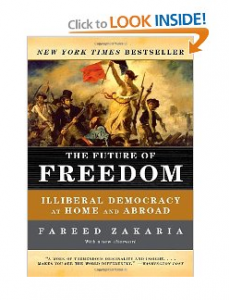 Several seniors with whom I work have recently been assigned their first nonfiction (read: non-textbook) book: The Future of Freedom by Fareed Zakaria. This is not light reading, and several of them feel lost. It’s a big jump to go from a textbook that force feeds you main ideas and subheadings, to a nonfiction book where main ideas have to be hunted down and highlighted.
Several seniors with whom I work have recently been assigned their first nonfiction (read: non-textbook) book: The Future of Freedom by Fareed Zakaria. This is not light reading, and several of them feel lost. It’s a big jump to go from a textbook that force feeds you main ideas and subheadings, to a nonfiction book where main ideas have to be hunted down and highlighted.
It’s especially a big leap if the student has never really *thought* about how ideas are structured, whether in textbooks or otherwise. So much of my job as an academic coach is to get students to slow down and pay attention to structure — of learning activities, the teacher’s lecture, or their own thinking. Perhaps I should call myself a meta-cognition coach!
My client Toby was writing a book review for The Future of Freedom and needed to identify Zakaria’s main ideas. However, Toby struggles with dyslexia and slow processing; he felt overwhelmed by the volume of ideas in the book and didn’t know how to glean the main point.
I pointed out that most nonfiction books are structured like a 5 paragraph essay, only longer. In a five paragraph essay we are guaranteed to find a concise statement of the main idea/theme of the book at the end of the introductory paragraph. Similarly, a nonfiction book will usually have a concise statement of the main idea in towards the end of the introductory chapter.
Toby and I checked it out; we scanned the final pages of the introduction looking for a clue, and sure enough: we found a paragraph that began with the words, “This book is a call for…”
Aha! I got really excited. If a book is “a call for” something, that’s a verbal clue that what follows will be a main idea!! As Toby and I read through the rest of that paragraph, it sure seemed like Mr. Zakaria was pointing to a main idea; however, before totally trusting what we’d found, Toby and I needed to double-check our thinking.
“Where else in a 5 paragraph essay can we find a concise restatement of the main idea?” I asked. “The conclusion?” Toby responded. Yes, yes! So we scanned the conclusion chapter of the book, to see if there was a repetition of the main idea we’d found in the introduction. Again, success!
By the time Toby left our session, he had not only figured out the main idea of The Future of Freedom, but he’d learned a great deal about how authors structure their own thinking. Plus, he’d discovered that the 5 paragraph essay structure is not just a method of torture, but it’s a basic way that anyone — even the most accomplished authors — often organize their ideas.
Not a bad lesson from a 40-minute coaching session!
Do you feel overwhelmed with reading, and taking notes on, nonfiction books? For step-by-step instructions about how to read more efficiently (so you have time for fun as well as studying), check this out. When you have a clear and specific set of guidelines that follows some basic brain rules AND works for your unique learning preferences, you’ll watch your grades go up while being able to enjoy your free time more. Doesn’t that sound like exactly what you need?

Well, Gretchen, you are, indeed, a teacher in the main stream of life! Teaching is my passion….so when I learn how others do this, I get excited. Your students are VERY LUCKY TO HAVE YOU!
to the wisdom of the body!
Marlys
Hi Marlys. You are such a regular reader of my blog! Thanks for such kind words. What is your teaching background/experience?
Awesome! Never seen so nice article. Keep going. You are the best blogger!